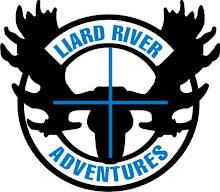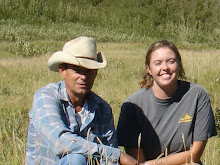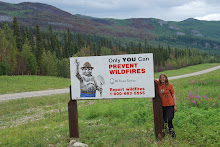
Landscape level heterogeneity in the Boreal (Sonja and Sam discussing heterogeneity) Photo credit: Ray Coupe, 2010
I had the extreme good fortune of returning home to Canada and having my research team come up to the North Country to work with me. Over 2 weeks in the summer, we monitored a range reference area on the Halfway River, attempted to do the Nevis Creek reference area, worked around Fort Nelson and up the highway to the Liard exclosures.
 It started with a sunset once the whole team arrived in the north country.
It started with a sunset once the whole team arrived in the north country.It was one of the greatest practical learning experiences that I have had. I am very thankful to my team for sharing their vast knowledge, following me up the Halfway for a 5 hour round trip every day on quad and then wading across it up to our hips (!) and for attempting the Nevis Creek dance as Ray Coupe called it. I am learning how to be a landscape/range/fire/wildlife ecologist/agrologist/scientist from the best that I know: Sam Fuhlendorf, Don Gayton, Ray Coupe and Marten Geertsema.
 The Research Team (excluding field assistants): Fuhlendorf, Geertsema, Gayton, Leverkus and Coupe 2010
The Research Team (excluding field assistants): Fuhlendorf, Geertsema, Gayton, Leverkus and Coupe 2010"You learn" by Alanis Morissette is playing in the background and so I feel it appropriate to share a few of the things that I was taught and plan to carry with me from these experiences:
1. The best made plans may not always turn out as you hope - have a back-up for the back-up plans.
2. The Prince George Fire Center provides outstanding safety back-up and I am very thankful for the good folks there who were flexible with our crazy schedule of 6am departures and midnights back to camp!
3. People made helicopters for a reason - sometimes it's too muddy to get some places.
4. Trust yourself - Ray Coupe forced me to leave my plant ID book in my pack at camp and that was the best thing he could have done. I only wish I could work with this great man every day. Trusting that we know the plants and their names - it takes some time to become intimate with one's place but without trusting oneself, that intimacy will always stay at one level, when there is so much more to it than having the ID book right beside you all the time.
5. Question and be critical and skeptical of everything.
6. Not all range people know all the range plants all around the world.
7. Sampling methods may not always account for all the variability that is present in a system.
8. Vertical structure is key! ie. how tall things grow in one area vs. another or is there a limiting factor to growth in one area over another -> herbivory?
9. Fire scars on trees, dendrochronology and pollen/charcoal in lake sediments - hard to argue with the presence of fire if you have these data sets.
10. Bison don't belong on the side of the Alaska highway as sacrificial red-listed species to be feasted upon by large automobiles
11. That the strength and guidance of 4 great men has come to mean the world to me.
 My best friend and yours (if you're into a beautiful bunchgrass that is high in protein throughout the winter) - Festuca altaica - Altai fescue.
My best friend and yours (if you're into a beautiful bunchgrass that is high in protein throughout the winter) - Festuca altaica - Altai fescue.Below are some pictures from this experience.

Avens
 Dr. Fuhlendorf.
Dr. Fuhlendorf. Crossing the Halfway
Crossing the Halfway Hoofing it to the Halfway Meadow Range Reference Area
Hoofing it to the Halfway Meadow Range Reference Area What is the difference you ask? Vertical structure. What is the reason for that you ask? Cold air drainage or perhaps bison grazing but not really an overindulgence in fire ... McQue Flats Range Reference Area.
What is the difference you ask? Vertical structure. What is the reason for that you ask? Cold air drainage or perhaps bison grazing but not really an overindulgence in fire ... McQue Flats Range Reference Area. Gayton along the transect line just after the hail storm.
Gayton along the transect line just after the hail storm. Would've been nice to have the key ... next time we'll know that there is a gate!
Would've been nice to have the key ... next time we'll know that there is a gate! Sam crossing the Halfway
Sam crossing the Halfway
Bogs
 Permafrost and Don Gayton
Permafrost and Don Gayton The team up at the Liard exclosures. Fire sure ruins the boreal forest eh?
The team up at the Liard exclosures. Fire sure ruins the boreal forest eh? Dr. Geertsema checking out the age of this spruce when the landslide occurred.
Dr. Geertsema checking out the age of this spruce when the landslide occurred. Number one chef extraordinaire on the Dunedin is Ray Coupe.
Number one chef extraordinaire on the Dunedin is Ray Coupe. The Research Team (missing: Don Gayton)
The Research Team (missing: Don Gayton) Sunset over the Halfway River Valley on our way back to base camp.
Sunset over the Halfway River Valley on our way back to base camp. On the top of Trutch (wild caraway and oxeye daisy spreading along the road systems ...)
On the top of Trutch (wild caraway and oxeye daisy spreading along the road systems ...) Other members of the pyric herbivory research team!
Other members of the pyric herbivory research team!











































No comments:
Post a Comment